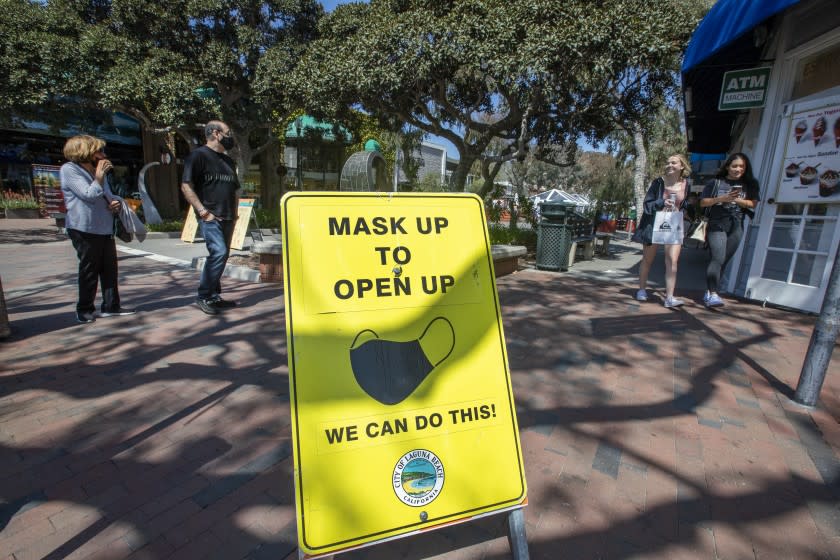Only one county left in purple tier as California's COVID-19 reopenings continue

Only one county remains in the strictest section of California's reopening road map, a heartening sign of progress in the battle against the coronavirus as businesses and other public spaces continue wider reopenings.
The lone remaining denizen of the purple tier is Merced County, according to state data released Tuesday. Inyo County had been keeping it company but officially moved into the less-restrictive red tier.
The recent exodus from the purple tier has been stunning. Thirty-four of California's 58 counties were in that category on March 9. The month before, all but five counties were in the tier.
Also progressing this week are Kern and Lake counties, which moved from the red to the even-more-lenient orange tier, and Lassen County, which progressed all the way to the yellow tier, the least restrictive of the four categories in the color-coded reopening blueprint.
As counties move through the tier framework, they're able to gradually reopen more types of businesses at greater capacity.
Key to the rapid move toward wider reopenings is that fewer Californians are being infected with the coronavirus even as more residents are getting their COVID-19 vaccinations.
Under the state's current reopening strategy, counties are placed into one of four color-coded tiers based on three metrics: coronavirus case rates, adjusted based on the number of tests performed; the rate of positive test results; and a health-equity metric intended to ensure that the positive test rate in poorer communities is not significantly higher than the county’s overall figure.
The metrics used to sort the counties, however, have changed over the past month as more Californians living in areas hard-hit by the coronavirus have been inoculated.
The state set a goal of administering 2 million — then 4 million — doses in targeted disadvantaged communities — those in the lowest quartile of a socioeconomic measurement tool called the California Healthy Places Index.
Upon hitting the initial 2-million target in mid-March, the state began allowing counties with an adjusted case rate of up to 10 new cases per day per 100,000 people to exit the purple tier and move into the red. Previously, counties needed to have case rates at or below 7 per 100,000 people to move into the red tier.
After reaching 4 million doses last week, the state further rewrote the blueprint to relax the criteria to move into the orange tier from a requirement of under 4 new cases per day per 100,0000 residents to under 6; and raised the allowable ceiling for entering the yellow tier to an adjusted daily new case rate below 2 per 100,000 people, up from the old requirement of less than 1.
The changes triggered a wave of reopenings, as dozens of counties were cleared to more rapidly progress into less-restrictive tiers.
Merced is very close to finally getting out of the purple tier. The only thing holding it back is its case rate, which, at 10.1, is still slightly too high.
The county would have to log two consecutive weeks of the required metrics to progress, meaning California's purple tier won't be empty until at least the end of the month.
In the past, counties have at times regressed to more restrictive tiers when case rates have worsened, but that possibility has lessened. The state now says that "unless there are extenuating circumstances, such as low rate of vaccine take up, a county will only move to a more restrictive tier if hospitalizations are increasing significantly among vulnerable individuals, especially among vaccinated individuals, and both test positivity and adjusted case rates show a concerning increase in transmission."
On June 15, the state plans to fold up its reopening road map. California has set that date as the target for full resumption of economic activity after more than a year of coronavirus-related closures.
Throwing the doors open hinges on two factors: a sufficient vaccine supply, and low, stable numbers of people hospitalized with COVID-19.
California continues to see promising signs on the latter front. Though there's been some oscillation, the number of COVID-19 patients in hospitals statewide on Monday — 1,839 — was as low as it had been since last spring.
Vaccine supply, though, is a stickier issue.
On Tuesday, California announced it would temporarily stop administering the single-shot Johnson & Johnson vaccine — a move federal health officials recommended following reports of six serious blood clots nationwide.
This followed news that the state — like the nation as a whole — would see expected shipments of that vaccine slashed.
Last week, 574,900 Johnson & Johnson doses were allocated to California. This week, that number will plummet to 67,600, an 88% drop, according to data from the Centers for Disease Control and Prevention.
And state health officials said that allocation was expected to fall further next week, to 22,400 doses.
Despite that drop, California will still open statewide vaccine access to residents 16 and older starting Thursday.
"As the federal government has said, we do not expect a significant impact to our vaccination allocations," state epidemiologist Dr. Erica Pan said in a statement. "In California, less than 4% of our vaccine allocation this week is the Johnson & Johnson vaccine.”
To date, providers throughout California have administered 23 million COVID-19 vaccine doses, and 38.8% of residents have received at least one shot, CDC data show.
Almost 875,000 Johnson & Johnson doses have been administered statewide to date, according to federal figures.
This story originally appeared in Los Angeles Times.

